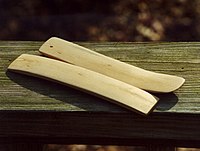| Revision as of 08:16, 9 March 2006 editJust plain Bill (talk | contribs)Extended confirmed users, Pending changes reviewers25,205 edits this pic in public domain← Previous edit | Revision as of 17:29, 12 March 2006 edit undoShyam (talk | contribs)Extended confirmed users25,334 editsNo edit summaryNext edit → | ||
| Line 1: | Line 1: | ||
| :''This article is about the musical instrument. For other meanings, see ]'' | :''This article is about the musical instrument. For other meanings, see ]'' | ||
| ] | |||
| ] | ] | ||
Revision as of 17:29, 12 March 2006
- This article is about the musical instrument. For other meanings, see Bone (disambiguation)


The bones are a musical instrument (more specifically, a folk instrument) which, at the simplest, consists of a pair of bones, human or animal, or pieces of wood or a similar material. Sections of large rib bones, such as those of a bovine, are the most commonly used true bones, although wooden sticks shaped like the earlier true bones are now more often used. They are about 5" to 7" in length and curved, roughly resembling miniature barrel staves.
They are played by holding them between one's fingers, convex surfaces facing one another, and moving one's wrist in such a way that they knock against each other. The customary method involves placing the bones to either side of the middle finger such that approximately two-thirds of their length extends along the palm while the remainder protrudes above the fingers on the backside of the hand. The hand is held in a loose fist with the bones and the curled fingers roughly parallel to the palm. Usually, the bone closest to the ring finger is gently held against the palm by the tip of the ring finger placed on its edge, while the other bone is left free to move in the "hinge" formed by the index and middle fingers as they gently hold it.

A critical element to playing the bones is not trying to force them to make contact with one another through finger manipulation but allowing their momentum to do the work. By moving the hand back and forth across the chest, with just enough force on the bones to keep them from falling out of the hand, a patient learner can produce a triple click. This "click-it-y" sound is the essential ingredient to playing the bones. A double-click can be produced by the same movement of the hand with the addition of a bit of pressure to the bones to suppress the third click. Once these elemental triple and double figures have been mastered, they can be combined to create complex combinations of rhythmic sounds. The effect is further enhanced by the use of two pair of bones, one in each hand. A skilled practitioner can produce a wide variety of percussive sounds reminiscent of those made by a tap dancer.
Categories: